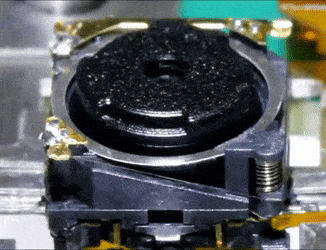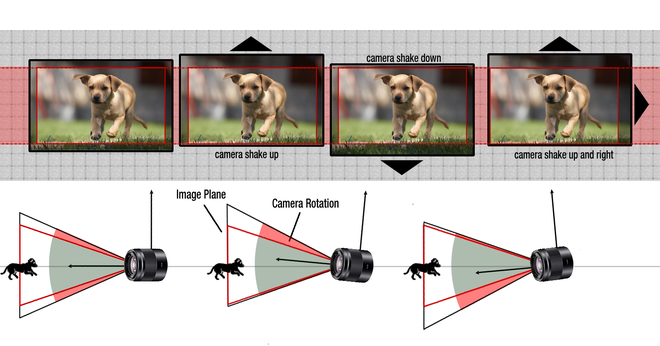The answer to the image stabilization technology on smartphones
- Tram Ho
Smartphone camera technology is built from a variety of components, from sensors, lenses, to laser focus systems. But right now, image stabilization is one of the most important systems in making a great smartphone camera.
Without it, your photos and selfies are easily blurred and out of focus, and the videos will look like they were recorded in the 80s. That’s because when taking a photo, the camera’s shutter will be opened. In order to capture the light entering the sensor, even a slight motion can blur the image. This is especially true when the shutter is open for a long time, for example when shooting in low light.

Realme X50 5G.
As HDR and night photography are becoming more common on smartphones, the presence of image stabilizers becomes even more essential than ever. In fact, nearly every smartphone today has image stabilization for at least one camera. However, there are several different types of image stabilization technology, so what are the pros and cons between them?
Optical Image Stabilization Technology – OIS (Optical Image Stabilization)
OIS is a hardware solution that uses gyroscope sensors (MEMS gyroscope) to detect movement and adjust the camera position accordingly. For example, if you are preparing to shoot with a smartphone but move your hand a bit to the left, the OIS system will detect this shift and move the camera a bit to the right to compensate.
Since this is a hardware solution, it will not have to crop away any part of the image, meaning that the entire image sensor on the phone will be devoted to image recording. In addition, videos recorded with the OIS system eliminate the distortion that is common in digital image stabilization systems. In addition, OIS also makes videos more natural, without having to use any editing effects.

Camera cluster equipped with OIS.
However, creating an accurate OIS kit is not cheap, meaning it will cost you more for a smartphone with this hardware. It also includes turning a regular stabilizer, a camera module into another moving part. Although rare, OIS moving parts can sometimes fail to function.
OIS is especially important when shooting in low light conditions, because the camera shutter usually opens longer than usual. Without OIS, photos will become smudged with a very small hand motion. With OIS, these slight movements are suppressed and produce sharper images. The same is true for telephoto cameras, where the field of view is very narrow, so even a slight vibration is amplified into a smudge on the image.
Electronic image stabilization technology – EIS
Image stabilization technology is similar to OIS, but EIS does not require special hardware. It works by using a smartphone accelerometer to detect every small movement. The camera software recognizes these movements and aligns each frame when shooting. For photography, this is very important during HDR processing and night shooting, when the camera takes multiple shots in a short period of time.

For video recording, the software will find a spot with high contrast and keep that point fixed in the frame. More modern EIS methods also use machine learning to detect a subject and lock it in the corresponding part of the frame. Taking advantage of available hardware and using software solutions helps this EIS cost much lower than OIS.
In return, EIS has a disadvantage that it can distort the frame unnaturally due to small changes in image perspective. This is also known as jelly-effect. But the biggest drawback of this technology must be the image cropping in the process.
When EIS is turned on, not all the sensors will be devoted to creating output images. The edges of the image sensor are used as buffers, so that the stabilized image can move in the rest of the sensor and keep the subject of the image stable in the frame. Without this buffer, when the stabilizer moved the camera, the edges of the image would be cut off.

Image sensor with padding at the edges for cropping images when stabilized by EIS.
Hybrid image stabilization technology – Hybrid Image Stabilization (HIS)
Like its name, HIS is a combination of OIS and EIS to create a more comprehensive solution. OIS will bring the image stabilization with basic hardware and then EIS will be added to make the video smoother. Thanks to OIS, the buffer area on the camera sensor for the EIS stabilizer will be smaller, resulting in less cropped final frames.
However, this HIS system does not bring significant benefits for photography. The OIS system itself is sufficient to ensure stabilization in many different photographic situations. Though. EIS systems can still be turned on to add stability when taking HDR photos or taking long exposure night shots.
Here’s an example on Google Pixel 2, the giant’s first smartphone to use a hybrid image stabilization system between OIS and EIS.
The video shows the effectiveness of HIS stabilization on Google Pixel 2.
But what if even HIS was not enough?
If even this hybrid image stabilization technology still does not meet your smoothness in video, the ultimate solution for you is to use a gimbal. Basically, this tool is a large gyroscope, which allows smartphone balance accurately and stably.
To do so, the gimbal uses small motors to counter arm movement by moving the phone in the opposite direction. However, the results are not always better than the image stabilization system on your phone.
Gimbal also has another significant benefit that allows you to control these motors to create smooth, smooth rotation and tilt movements. It also has a control key integrated into the handle to allow users to manipulate gimbal movements.

Gimbal offers good vibration resistance but is also not cheap.
The benefits of gimbal come with a price that is not very pleasant, usually from 80 USD to 140 USD depending on the brand, version and accessories included. Besides, the fact that you have to carry an accessory that can’t fit into your pocket is also a quite expensive price compared to normal usage.
Currently, almost every major smartphone camera has EIS in some form, and most of them also have OIS. Therefore, as long as you buy yourself a decent smartphone, you will not have to worry about image stability when shooting. Moreover, these devices will also come with many other advanced imaging features to take advantage of image stabilization.
It is worth noting that wide-angle lenses often do not need the OIS system when shooting movies due to their wider field of view than telephoto lenses and have the support from EIS. But if you want to take photos remotely with a telephoto lens, OIS is definitely a better choice than EIS.
Also unless you want to shoot a short movie with a smartphone, the need for a gimbal doesn’t seem necessary when the improvements in HIS technology are now sufficient. Now even mid-range smartphones can provide great image stabilization.
Refer to Android Authority
Nguồn bài viết : Genk
